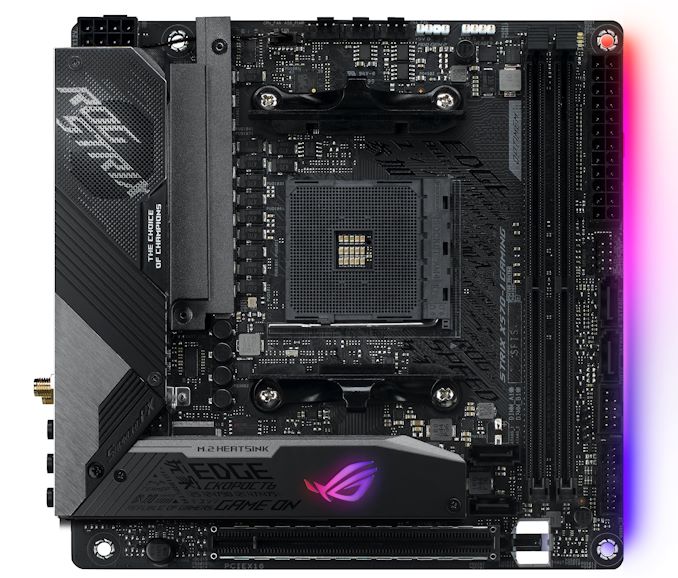The AMD X570 Motherboard Overview: Over 35+ Motherboards Analyzed
by Gavin Bonshor on July 9, 2019 8:00 AM ESTASUS ROG Strix X570-I Gaming
The ASUS ROG Strix X570-I Gaming is a small form factor gaming-focused and represents its more mid-range Strix brand. Based on the smaller Mini-ITX form factor, the X570-I Gaming has plenty to shout about including two PCIe 4.0 M.2 slots and eight SATA ports which is quite impressive for a small form factor to feature.
There is a single full-length PCIe 4.0 x16 slot in addition to two memory slots with support for up to 64 GB of DDR4 memory. The aesthetic is similar to the ATX sized X570 Strix models with a graffiti-inspired graphic on the M.2 heatsink, which also extends around to the rear panel cover for a uniformed look. There is RGB LED lighting built into the heatsink, with a strip underneath the right-hand side of the PCB for an ambient styled glow. In terms of storage, the ASUS ROG Strix X570-I Gaming has eight SATA ports and two PCIe 4.0 x4 M.2 slots; one is located on the front just above the full-length PCIe 4.0 x16 slot which includes a heatsink, while the other sits on the rear of the boards PCB.
Aimed at the mid to high-end gamers, the ASUS ROG Strix X570-I Gaming has a ROG SupremeFX S1220 HD audio codec which powers three 3.5 mm audio jacks, with three USB 3.1 G2 Type-A, one USB 3.1 G2 Type-C, and four USB 3.1 G1 Type-A ports also on the rear panel. Interestingly ASUS includes a DisplayPort 1.4 and HDMI 2.0 pairing of video outputs on the rear for use with the newly announced AMD Ryzen 3000 series APUs. The ROG Strix X570-I rear panel also has an Intel I211-AT Gigabit NIC powering the single Ethernet port, as well as an Intel AX200 802.11ax Wi-Fi 6 wireless interface which also includes support for BT 5.
The ASUS ROG Strix X570-I Gaming at present doesn't have an MSRP as isn't being launched with the rest of its product stack, and it represents the only mini-ITX sized model in the line-up; the ROG Crosshair VIII Impact is actually mini-DTX. A mixture of premium components, good storage capabilities and a Wi-Fi 6 802.11ax wireless interface an attractive model for users looking to build a potent small form factor gaming system.











225 Comments
View All Comments
DigitalFreak - Tuesday, July 9, 2019 - link
Agreed. The major differences between pricing in motherboards nowadays is how well they support overclocking, how many / what type of Ethernet ports, and how much RGB garbage they throw on there. :-)brunis.dk - Wednesday, July 10, 2019 - link
Retarded Garbage Blinking!29a - Wednesday, July 10, 2019 - link
RGB changes the price by pennies at the most.jrs77 - Tuesday, July 9, 2019 - link
If it wasn't for the optical digital output I'd agree, but these seem to be rather rare and not common at all. A couple years back that wasn't the case, so I see an actual backwards trend here that comes with a lack of necessary ports. Atleast an optical digital output is necessary for me.lmcd - Friday, July 26, 2019 - link
I mean sure, but a decent number of them were completely useless from a terrible onboard chipset. Pretty sure one of my two desktops had one that maxed out at 2.0 channel over optical digital output.Silma - Thursday, July 11, 2019 - link
This would have been true, but for the dearth of ThunderBolt 3 ports, needed for audio interfaces for example.lso the price of most of the boards is outrageous compared to their real added value, imho.
umano - Friday, July 12, 2019 - link
I agree with Silma, for example the great asrock x299 itx at launch had a price tag of 399, with 4 memory channel and sodimm slot and 3 nvme. Something's wrong, or the amd statement is false (most modern i/o), or the mb manufacturers did not get the best from x570regsEx - Friday, July 19, 2019 - link
I like it either. But back in days, top Intel's Asrock P67 Fatali1y Professional was priced at $120. For that price you were getting 16+2 phase power, cooling with a pipe 3 brand new Etron USB 3.0 controllers (USB 3.2 Gen 1), additional PCIe controller, best at the time Realtek ALC892 sound, 2 Realtek RTL8111 LAN controllers, additional Marvell SATA controller, Dr. Debug display, power and reset buttons, 3.5" front USB 3 panel, additional rear USB 3 bracket and SLI bridge in the box. That was first generation of motherboards of XMP profiles and new graphical AMI UEFI (return of graphical AMI BIOS after 15 years) etc etc. Just $120. Now to get similar set you have to pay at least $360. And for $120 you can only get some poor office board. And ASRock was cheapest of high end boards back then. Now it's most expensive.regsEx - Friday, July 19, 2019 - link
"best at the time Realtek ALC892 sound"I mean best of Realtek. Obviously there were Creative X-Fi.
Marlin1975 - Tuesday, July 9, 2019 - link
How soon before you can test the x570 boards? Really curious how pcie 3 m.2 cards perform in them with 2000 and 3000 series cpus. Does the new chipset help performance for 2000 cpus or even 3000 cpus compared to x470 and b450 boards?And any word on future mATX boards? Only 1 so far seems weird and also a monoply for asrock.